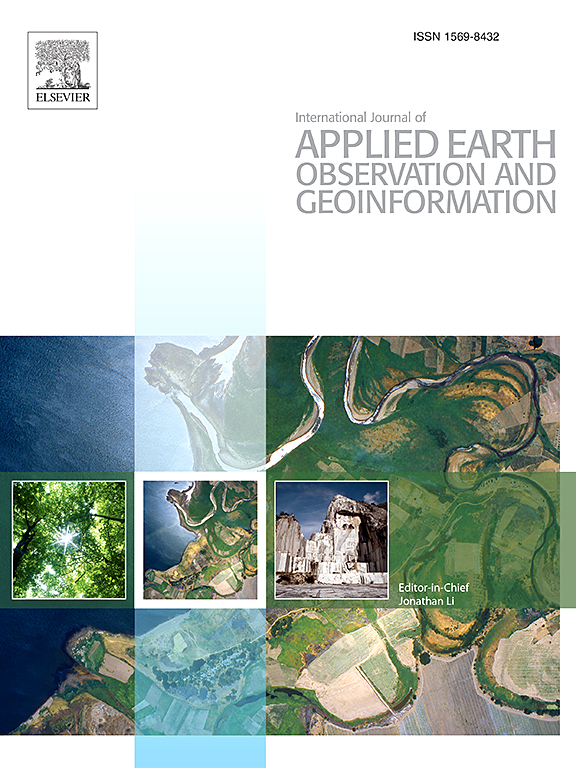Fine-scale Antarctic grounded ice cliff 3D calving monitoring based on multi-temporal UAV photogrammetry without ground control
IF 7.6
Q1 REMOTE SENSING
International journal of applied earth observation and geoinformation : ITC journal
Pub Date : 2025-06-17
DOI:10.1016/j.jag.2025.104620
引用次数: 0
Abstract
Grounded ice cliffs in Antarctica contribute directly to global sea level rise through calving, yet they are less studied compared to floating ice shelves. Traditional satellite remote sensing methods face limitations in temporal and spatial resolution for monitoring these small-scale calving events. This research aims to develop a method for fine-scale monitoring of grounded ice cliff calving using multi-temporal UAV photogrammetry without ground control points, with assistance from in-situ snow pit measurements. The methodology involves co-aligning UAV images to create consistent 3D models, followed by detecting calving events based on significant local volume changes between successive models. Noise filtering strategies were implemented to exclude outliers, and calving volume and mass were calculated using measurements of snow depth and density. Our method was conducted near the China’s Qinling Station on Inexpressible Island in Victoria Land, East Antarctica, and achieved a co-alignment accuracy of 2.69 cm. Over a 26-day observation period with 10 repeated flights, 44 calving events were identified along the coastline of 0.89 km, resulting in a total calving volume of 4506.69 m3 and a mass of 3078.45 tons. The average calving rate was determined to be 262.93 tons per kilometre per day along the coastline. This study demonstrates the effectiveness of fine-scale monitoring of grounding ice-cliff calving using UAV photogrammetry in polar environments. Further research is necessary to identify the spatial distribution of the Antarctic grounded ice cliffs and to quantify the total mass loss.
基于多时相无人机无地面控制的南极地面冰崖精细尺度三维崩解监测
南极洲搁浅的冰崖通过崩解直接导致全球海平面上升,但与漂浮的冰架相比,对它们的研究较少。传统的卫星遥感方法在监测这些小尺度冰裂事件的时间和空间分辨率方面存在局限性。本研究旨在开发一种利用多时相无人机摄影测量技术,在没有地面控制点的情况下,借助现场雪坑测量,对地面冰崖崩解进行精细监测的方法。该方法包括将无人机图像对齐以创建一致的3D模型,然后根据连续模型之间显著的局部体积变化检测产犊事件。采用噪声滤波策略排除异常值,并利用积雪深度和密度测量计算产犊体积和质量。该方法在中国东南极洲维多利亚地不可表达岛秦岭站附近进行,共准精度为2.69 cm。在为期26天的10次重复飞行观测中,沿0.89 km海岸线共发现44次产犊事件,产犊总体积为4506.69 m3,质量为3078.45吨。沿海岸线的平均产犊率为每天每公里262.93吨。本研究验证了利用无人机摄影测量技术对极地环境下地面冰崖崩解进行精细监测的有效性。确定南极地面冰崖的空间分布和量化总质量损失需要进一步的研究。
本文章由计算机程序翻译,如有差异,请以英文原文为准。
求助全文
约1分钟内获得全文
求助全文
来源期刊

International journal of applied earth observation and geoinformation : ITC journal
Global and Planetary Change, Management, Monitoring, Policy and Law, Earth-Surface Processes, Computers in Earth Sciences
CiteScore
12.00
自引率
0.00%
发文量
0
审稿时长
77 days
期刊介绍:
The International Journal of Applied Earth Observation and Geoinformation publishes original papers that utilize earth observation data for natural resource and environmental inventory and management. These data primarily originate from remote sensing platforms, including satellites and aircraft, supplemented by surface and subsurface measurements. Addressing natural resources such as forests, agricultural land, soils, and water, as well as environmental concerns like biodiversity, land degradation, and hazards, the journal explores conceptual and data-driven approaches. It covers geoinformation themes like capturing, databasing, visualization, interpretation, data quality, and spatial uncertainty.
 求助内容:
求助内容: 应助结果提醒方式:
应助结果提醒方式:


